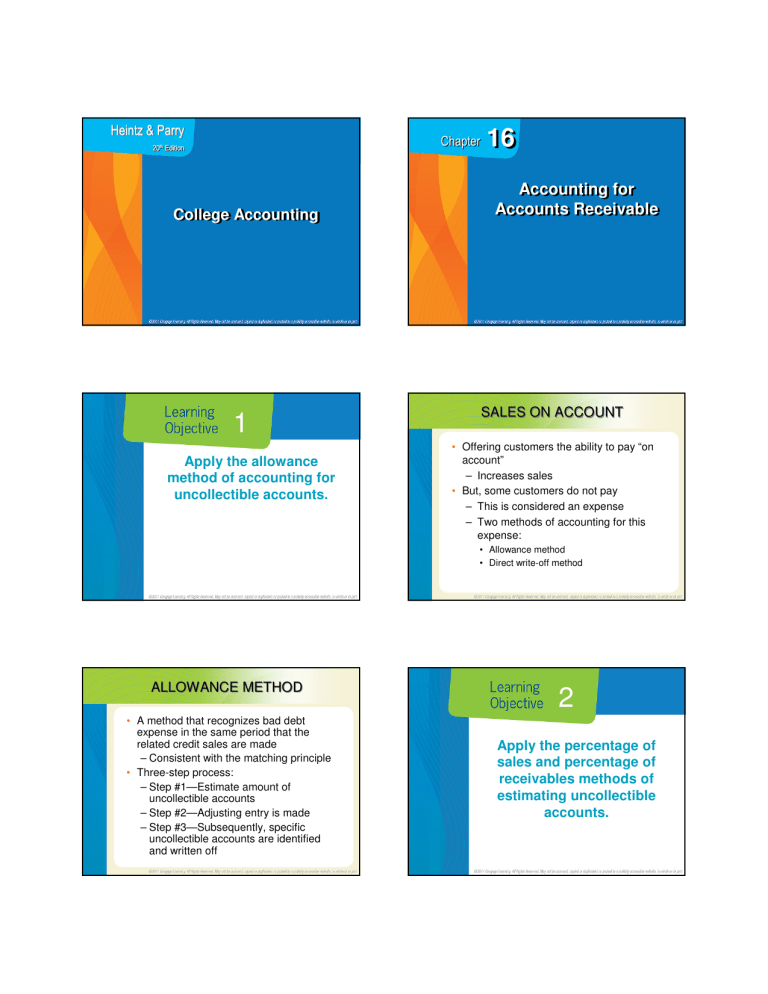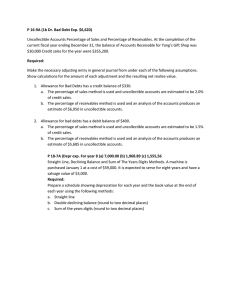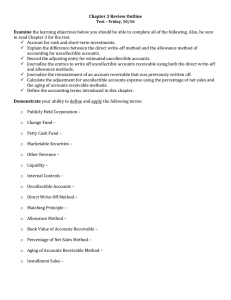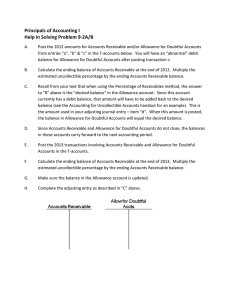
Heintz & Parry
Chapter
20thth Edition
College
College Accounting
Accounting
1
Apply the allowance
method of accounting for
uncollectible accounts.
16
Accounting
Accounting for
for
Accounts
Accounts Receivable
Receivable
SALES ON ACCOUNT
• Offering customers the ability to pay “on
account”
– Increases sales
• But, some customers do not pay
– This is considered an expense
– Two methods of accounting for this
expense:
• Allowance method
• Direct write-off method
ALLOWANCE METHOD
• A method that recognizes bad debt
expense in the same period that the
related credit sales are made
– Consistent with the matching principle
• Three-step process:
– Step #1—Estimate amount of
uncollectible accounts
– Step #2—Adjusting entry is made
– Step #3—Subsequently, specific
uncollectible accounts are identified
and written off
2
Apply the percentage of
sales and percentage of
receivables methods of
estimating uncollectible
accounts.
STEP #1 ESTIMATING
UNCOLLECTIBLE ACCOUNTS
PERCENTAGE OF SALES METHOD
Step #1 Determine the % of credit sales
expected to become uncollectible
• Two methods:
– Percentage of sales method
• Based on the relationship between the
amount of credit sales and the amount of
uncollectible accounts
This can be done by looking at the
company’s prior credit experience,
industry averages, or percentages
for similar companies.
– Percentage of receivables method
• Based on the relationship between the
amount of accounts receivable and the
amount of uncollectible accounts
PERCENTAGE OF SALES METHOD
EXAMPLE: During the next year, Chris Co. has
credit sales of $120,000. What amount should
be recorded as “Bad Debt Expense” for this
year?
EXAMPLE: Chris Co. had total credit sales of
$200,000, and $2,000 of those credit sales
had become uncollectible.
Uncollectible Accounts
Credit Sales
=
$2,000
= 1%
$200,000
This is used in future periods to
estimate uncollectible accounts.
DATE
20-Dec.
DESCRIPTION
Adjusting Entries
31 Bad Debt Expense
Allowance for Bad Debts
Estimated
Credit
Est. %
Uncollectible
Sales × Uncollectible =
Accounts
$120,000 ×
GENERAL JOURNAL
1
2
3
4
PERCENTAGE OF SALES METHOD
1%
=
$1,200
PERCENTAGE OF SALES METHOD
PR DEBIT CREDIT
Subsequent write-offs
1,200
1,200
5
6
7
8
9
10
11
The income statement will show…
Revenues (Sales) of $120,000
and Bad Debt Expense of $1,200.
©2011 Cengage Learning. All Rights Reserved. May not be scanned, copied or duplicated, or posted to a publicly accessible website, in whole or in part.
Let’s look at how write-offs are
recorded under the allowance method.
GENERAL JOURNAL
PERCENTAGE OF SALES METHOD
DATE
1
2
3
4
Subsequent write-offs
5
Under the allowance method,
write-offs affect the
balance sheet only!
6
7
DESCRIPTION
Allowance for Bad Debts
PR DEBIT CREDIT
1,100
Accts. Rec./Cust. Names
1,100
The allowance account, accounts receivable
account, and subsidiary ledger account
are all reduced.
8
9
10
11
GENERAL JOURNAL
DATE
1
2
3
DESCRIPTION
Allowance for Bad Debts
PERCENTAGE OF RECEIVABLES
METHOD
PR DEBIT CREDIT
1,100
Accts. Rec./Cust. Names
1,100
4
5
6
7
8
9
©2011 Cengage Learning. All Rights Reserved. May not be scanned, copied or duplicated, or posted to a publicly accessible website, in whole or in part.
The bad debt expense account is not affected.
The expense of this uncollectible account was
recognized in the adjusting entry in the
period of the related sale.
Simplest form: Apply an estimated
percentage of uncollectible accounts to the
Accounts Receivable balance, to determine
“Estimated Uncollectible Accounts”
10
11
©2011 Cengage Learning. All Rights Reserved. May not be scanned, copied or duplicated, or posted to a publicly accessible website, in whole or in part.
PERCENTAGE OF RECEIVABLES
METHOD
EXAMPLE: Craft Co. had an average Accounts
Receivable balance at the end of the past two
years of $110,000, and average uncollectible
accounts of $4,400.
Avg. Uncollectible Accts.
$4,400
= 4%
=
Average Accounts
$110,000
Receivable
This is used in future periods to
estimate uncollectible accounts.
PERCENTAGE OF RECEIVABLES
METHOD
EXAMPLE: At the end of the current year the
Accounts Receivable balance was $120,000.
What amount should be recorded as “Bad
Debt Expense” for this year?
Estimated
Accts.
Est. %
Uncollectible
×
Rec.
Uncollectible =
Accounts
$120,000 ×
4%
=
$4,800
GENERAL JOURNAL
DATE
1
2
3
4
20-Dec.
DESCRIPTION
Adjusting Entries
AGING THE RECEIVABLES
PR DEBIT CREDIT
• An aging schedule is prepared, which
details:
– Each customer’s account balance and
how long it has been outstanding
– Estimated percentage uncollectible
based on the “age” of the account
• This computes a more precise estimate of
uncollectible accounts
4,800
31 Bad Debt Expense
Allowance for Bad Debts
4,800
5
6
7
8
9
10
11
Assuming the allowance account has a
zero balance prior to this adjustment.
©2011 Cengage Learning. All Rights Reserved. May not be scanned, copied or duplicated, or posted to a publicly accessible website, in whole or in part.
AGING SCHEDULE OF ACCOUNTS RECEIVABLE—Dec 31, 20-1
Customer
W. Billiard
K. Campbell
J. Farley
L. Gilbert
E. Rome
Not Yet Due
Total
$ 3,000
$ 2,500
950
4,325
3,800
1,900
1,500
3,170
3,950
AGING SCHEDULE OF ACCOUNTS RECEIVABLE—Dec 31, 20-1
1-30
$ 500
31-60
$ 650
$ 300
$ 780
The balances are separated
and classified by how long they
have been outstanding.
©2011 Cengage Learning. All Rights Reserved. May not be scanned, copied or duplicated, or posted to a publicly accessible website, in whole or in part.
AGING SCHEDULE OF ACCOUNTS RECEIVABLE—Dec 31, 20-1
Total
Not Yet Due
$ 3,000
$ 2,500
950
4,325
3,800
1,900
1,500
3,170
3,950
200
$100,500
$65,000
AGING SCHEDULE OF ACCOUNTS RECEIVABLE—Dec 31, 20-1
Customer
W. Billiard
K. Campbell
J. Farley
L. Gilbert
E. Rome
B. Zimmerman
Total
Not Yet Due
Total
$ 3,000
$ 2,500
950
4,325
3,800
1,900
1,500
3,170
3,950
200
$100,500
$65,000
Estimated percent uncollectibles
2%
Total est. uncollectible accounts
$1,300
Each category is totaled.
©2011 Cengage Learning. All Rights Reserved. May not be scanned, copied or duplicated, or posted to a publicly accessible website, in whole or in part.
Over 365
200
©2011 Cengage Learning. All Rights Reserved. May not be scanned, copied or duplicated, or posted to a publicly accessible website, in whole or in part.
B. Zimmerman
Total
181-365
400
Customers and balances
are listed.
Customer
91-180
$ 525
200
B. Zimmerman
W. Billiard
K. Campbell
J. Farley
L. Gilbert
E. Rome
61-90
Percentages, based on past experience
are applied to each category.
©2011 Cengage Learning. All Rights Reserved. May not be scanned, copied or duplicated, or posted to a publicly accessible website, in whole or in part.
AGING SCHEDULE OF ACCOUNTS RECEIVABLE—Dec 31, 20-1
$
1-30
500
31-60
61-90
91-180
$ 650
181-365
AGING SCHEDULE OF ACCOUNTS RECEIVABLE—Dec 31, 20-1
Customer
Over 365
W. Billiard
K. Campbell
J. Farley
L. Gilbert
E. Rome
$ 300
$ 525
400
The percentage increases as the accounts
$ 780
become older and less likely to be collected.
All the categories’ estimated
200
uncollectible accounts are
totaled. $65,000
$100,500
$18,000
$8,250
$6,310
200
$1,810
$780
$350
B. Zimmerman
Total
5%
10%
20%
30%
50%
80%
Estimated percent uncollectibles
900
$ 825
$1,262
$ 543
$390
$280
Total est. uncollectible accounts
$
©2011 Cengage Learning. All Rights Reserved. May not be scanned, copied or duplicated, or posted to a publicly accessible website, in whole or in part.
DATE
DESCRIPTION
Adjusting Entries
5,500
Allowance for Bad Debts
5,500
DATE
1
2
3
4
4
5
5
6
6
7
7
8
9
Assuming the allowance account has a
zero balance prior to this adjustment.
10
11
$ 5,500
$ 1,300
GENERAL JOURNAL
PR DEBIT CREDIT
20-Dec. 31 Bad Debt Expense
2%
©2011 Cengage Learning. All Rights Reserved. May not be scanned, copied or duplicated, or posted to a publicly accessible website, in whole or in part.
GENERAL JOURNAL
1
2
3
Total
Not Yet Due
$ 3,000
$ 2,500
950
4,325
3,800
1,900
1,500
3,170
3,950
DESCRIPTION
Allowance for Bad Debts
PR DEBIT CREDIT
5,200
Accts. Rec./Cust. Names
5,200
During the year, accounts
totaling $5,200 are written off.
8
9
10
©2011 Cengage Learning. All Rights Reserved. May not be scanned, copied or duplicated, or posted to a publicly accessible website, in whole or in part.
AGING THE RECEIVABLES
Allowance for Bad Debts
Write-offs
during 20-2
5,500
12/31/-1 Adj.
300
12/31/-2 Bal.
11
©2011 Cengage Learning. All Rights Reserved. May not be scanned, copied or duplicated, or posted to a publicly accessible website, in whole or in part.
AGING THE RECEIVABLES
EXAMPLE: At the end of 20-2, another aging
schedule is prepared, and it shows estimated
uncollectible accounts of $5,700.
5,200
After write-offs, the allowance account
is left with a $300 credit balance.
The $5,700 is the balance needed
in the allowance account.
AGING THE RECEIVABLES
AGING THE RECEIVABLES
Allowance for Bad Debts
Allowance for Bad Debts
Write-offs
during 20-2
5,500
12/31/-1 Adj.
5,200
300
Need a balance of $5,700,
but the balance is only $300.
5,700
5,500
12/31/-1 Adj.
300
12/31/-2 Bal.
5,200
12/31/-2 Bal.
Desired
12/31/-2 Bal.
COMPARISON OF ALLOWANCE
METHODS
PERCENTAGE
OF SALES
PERCENTAGE OF
RECEIVABLES
Basis for
estimate
% of credit sales
Aging (%) of accounts
receivable
Amount of
year-end
adjustment
Amount calculated
above
Amount calculated above
plus debit balance in
allowance account before
adjustment or minus
credit balance in
allowance account before
adjustment
FEATURE
Write-offs
during 20-2
EFFECT OF WRITE-OFFS
• On the income statement
– No effect
– The expense was already recognized
during the adjusting entry
• On the balance sheet
– No effect overall
– The write-off decreases both the asset
(Accounts Receivable) and the contraasset (Allowance for Bad Debts)
An adjustment of
$5,400 is needed.
5,400
5,700
Adj.
Desired
12/31/-2 Bal.
COMPARISON OF ALLOWANCE
METHODS
FEATURE
PERCENTAGE
OF SALES
PERCENTAGE OF
RECEIVABLES
Balance after Amount calculated above Amount calculated
above
adjustment
plus debit balance in
allowance account before
adjustment or minus
credit balance in
allowance account before
adjustment
RECOVERY OF A PREVIOUSLY
WRITTEN-OFF ACCOUNT
EXAMPLE: A check for $500 was received on
February 1 from Bill McDonald, whose
account was written off on January 15.
This requires two entries!
GENERAL JOURNAL
1
2
3
4
DATE
DESCRIPTION
20-Feb. 1 Accts. Rec./B. McDonald
Allowance for Bad Debts
GENERAL JOURNAL
PR DEBIT CREDIT
500
500
Reinstated acct. receivable
5
6
7
8
9
10
11
1
2
3
4
5
Step #1
Reinstate the account
(reverse the write-off).
Collection on account
©2011 Cengage Learning. All Rights Reserved. May not be scanned, copied or duplicated, or posted to a publicly accessible website, in whole or in part.
GENERAL JOURNAL
PR DEBIT CREDIT
500
500
1
2
3
4
5
5
J. Lafollete’s account is written off
under the direct write-off method.
8
9
10
11
Step #2
Record the collection.
• Bad Debt Expense is not recognized until it has
been determined that an account is uncollectible
• Advantage:
– It’s simple
• Disadvantages:
– Violates the matching principle
– The amount of the expense can be
manipulated
– The balance sheet does not reflect the amount
of Accounts Receivable actually expected to
be received
GENERAL JOURNAL
7
500
DIRECT WRITE-OFF METHOD
Apply the direct write-off
method of accounting for
uncollectible accounts.
6
500
7
3
DATE
DESCRIPTION
20X1
1 Aug. 15 Bad Debt Expense
2
Accts. Rec./J. Lafollette
3
4
1 Cash
Accts. Rec./B. McDonald
10
11
PR DEBIT CREDIT
500
500
Reinstated acct. receivable
6
8
9
©2011 Cengage Learning. All Rights Reserved. May not be scanned, copied or duplicated, or posted to a publicly accessible website, in whole or in part.
DATE
DESCRIPTION
20-1 Accts. Rec./B. McDonald
Feb.
Allowance for Bad Debts
6
7
DATE
DESCRIPTION
20X1
Aug. 15 Bad Debt Expense
Accts. Rec./J. Lafollette
PR DEBIT CREDIT
500
500
If he subsequently pays the $500
IN THE SAME ACCOUNTING PERIOD,
two entries are needed.
8
9
©2011 Cengage Learning. All Rights Reserved. May not be scanned, copied or duplicated, or posted to a publicly accessible website, in whole or in part.
10
11
©2011 Cengage Learning. All Rights Reserved. May not be scanned, copied or duplicated, or posted to a publicly accessible website, in whole or in part.
GENERAL JOURNAL
1
2
3
4
5
DATE
DESCRIPTION
20X1
Aug. 15 Bad Debt Expense
Accts. Rec./J. Lafollette
Dec.
GENERAL JOURNAL
PR DEBIT CREDIT
500
500
20 Accts. Rec./J. Lafollette
Bad Debt Expense
500
500
6
10
11
5
7
Step #1
Reinstate the account
(reverse the write-off).
8
9
10
11
©2011 Cengage Learning. All Rights Reserved. May not be scanned, copied or duplicated, or posted to a publicly accessible website, in whole or in part.
GENERAL JOURNAL
1
2
3
DATE
DESCRIPTION
20X1
Aug. 15 Bad Debt Expense
Accts. Rec./J. Lafollette
PR DEBIT CREDIT
500
500
1
2
3
4
5
5
7
8
9
Now let’s see how the entries would be
different if he subsequently pays the $500,
IN A DIFFERENT ACCOUNTING PERIOD.
7
8
9
10
11
©2011 Cengage Learning. All Rights Reserved. May not be scanned, copied or duplicated, or posted to a publicly accessible website, in whole or in part.
GENERAL JOURNAL
1
2
3
4
5
DATE
DESCRIPTION
20X1
Aug. 15 Bad Debts Expense
PR DEBIT CREDIT
500
500
Accts. Rec./J. Lafollette
20X2
Jan. 20 Accts. Rec./J. Lafollette
Uncol. Accts. Recovered
500
500
6
7
8
9
10
11
500
20 Accts. Rec./J. Lafollette
Bad Debt Expense
500
20 Cash
Accts. Rec./J. Lafollette
500
500
500
20 Cash
500
Step #2 Record the collection.
©2011 Cengage Learning. All Rights Reserved. May not be scanned, copied or duplicated, or posted to a publicly accessible website, in whole or in part.
Accts. Rec./J. Lafollette
Step #2
Record the collection.
©2011 Cengage Learning. All Rights Reserved. May not be scanned, copied or duplicated, or posted to a publicly accessible website, in whole or in part.
DATE
DESCRIPTION
20X1
Aug. 15 Bad Debt Expense
Accts. Rec./J. Lafollette
PR DEBIT CREDIT
500
20X2
Jan. 20 Accts. Rec./J. Lafollette
Uncol. Accts. Recovered
500
500
6
10
11
Dec.
PR DEBIT CREDIT
500
GENERAL JOURNAL
4
6
DATE
DESCRIPTION
20X1
Aug. 15 Bad Debt Expense
Accts. Rec./J. Lafollette
6
7
8
9
1
2
3
4
500
Step #1
Reinstate the account
crediting a REVENUE account
instead of subtracting from
Bad Debt Expense.
©2011 Cengage Learning. All Rights Reserved. May not be scanned, copied or duplicated, or posted to a publicly accessible website, in whole or in part.
500








